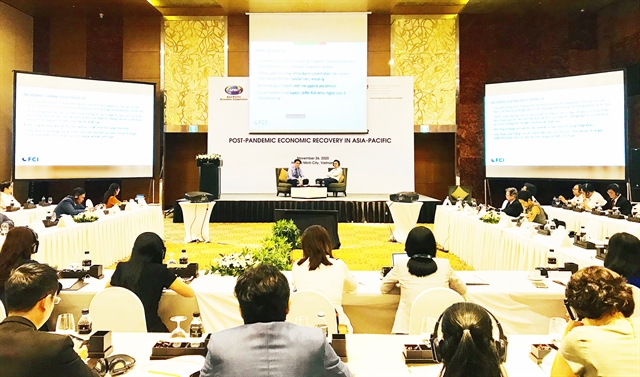 Economy
Economy

As financial markets have increasingly become globalised, a more robust regional financial infrastructure network is needed to facilitate trade among APEC-member economies, ensuring economic recovery and inclusive growth in the Asia Pacific region after the pandemic ends, according to Qamar Saleem, the International Finance Corporation’s Asia-Pacific manager for Financial Institutions Group Advisory Services.

|
| Speakers at the eighth APEC Financial Infrastructure Development Network Conference in HCM City. VNS Photo Bồ Xuân Hiệp |
HCM CITY — As financial markets have increasingly become globalised, a more robust regional financial infrastructure network is needed to facilitate trade among APEC-member economies, ensuring economic recovery and inclusive growth in the Asia Pacific region after the pandemic ends, according to Qamar Saleem, the International Finance Corporation’s Asia-Pacific manager for Financial Institutions Group Advisory Services.
Saleem spoke at the eighth APEC Financial Infrastructure Development Network Conference last week in HCM City. Around 150 representatives from ministries and agencies, think-tank organisations and financial institutions, value-chain lead firms, and suppliers and distributors across the region participated in the conference.
Lê Anh Tuấn, director of the National Credit Information Centre’s Research, Development and Marketing Division (State Bank of Việt Nam), noted that as a “pillar of Việt Nam’s financial infrastructure, the National Credit Information Centre aims to help the financial market grow with high quality”.
The centre has stepped up efforts to reform the national database of credit information, improve IT Infrastructure, and enhance credit information products and services, he added. For example, it has helped to expand the coverage of the Credit Reporting System to outside the industry, diversifying data sources for credit institutions to evaluate borrowers.
The centre has also helped Việt Nam reach a maximum score in the depth of credit information index. The country achieved a high ranking in the World Bank Group’s Doing Business report, providing effective information to credit institutions to grant credit to SMEs.
In addition, it has assisted borrowers, especially SMEs, to have better access to reputable financial resources to recover from the pandemic, Tuấn said.
Jonas Grunder, deputy head of Cooperation at the Embassy of Switzerland, said: “We have been partnering with IFC, the State Bank of Việt Nam and the Ministry of Justice over the past few years to develop a movables finance market, which is essential for supply chain financing in the country.
“We will continue intensifying efforts to expand financing for micro, small and medium enterprises (MSMEs) participating in global supply chains.”
Supply chain finance
Also speaking at the conference, Mohammad Mudasser, director of PwC Việt Nam, said: “With supply chain finance (SCF) being a solution to optimise working capital, developing the SCF market requires attention to distinctive features and diversity for all market participants to fully support the economy and financial inclusion for SMEs.”
Despite having a secured transaction framework, SCF penetration is limited in Việt Nam. But there is an opportunity to develop or grow SCF by five or six times over the next five years, he said.
“Our review and research has also found a few misconceptions surrounding SCF in Việt Nam, which may have led ar too less SCF penetration. The reality is no SCF products are currently prohibited under Vietnamese laws and regulations,” he said.
“Việt Nam’s secured transactions framework is more descriptive than some other countries such as China, France and Germany where SCF products, such as factoring, are commonly provided to businesses.”
In Việt Nam, financial services are one of the critical elements for improving the competitiveness of supply chains.
Supply chain finance that links buyers, suppliers and financial institutions will enable suppliers and distributors to optimise their working capital management by converting their sales receivables and inventories to cash and giving them lower-cost financing.
It will also allow suppliers to conduct more open-account transactions, making them more attractive to global buyers.
Việt Nam’s foreign trade volume has increased in recent years as free-trade agreements are opening new market opportunities for local businesses. However, a lack of working capital and transaction banking services such as SCF partially hinders producers and suppliers, especially SMEs, from accepting large orders or developing new relationships with their value chain actors.
As a result, the share of receivables and inventory registered as movable collateral in the country is about 30 per cent, compared with 60 per cent in China and 80 per cent in mature markets globally, according to the event’s organisers.
Việt Nam has great potential for SCF, which was estimated to reach $33 billion in 2018.
Experts said that a regulatory framework on SCF should be created, and that an e-platform for supply chain financing should be established in Việt Nam.
IFC in partnership with the Swiss Secretariat for Economic Affairs is implementing a multi-year advisory programme to facilitate supply chain financing for Vietnamese SMEs by improving the regulatory framework, sector infrastructure, capacities of SCF providers, and awareness of SME suppliers.
Organised both virtually and physically (for those based in HCM City) by the APEC Business Advisory Council, Asia-Pacific Financial Forum, IFC and the State Bank of Việt Nam, this year’s conference focused on the theme of “Financial Infrastructure Support for Post-Pandemic Economic Recovery in Asia Pacific.” — VNS